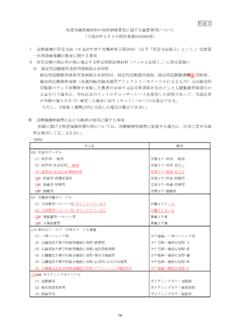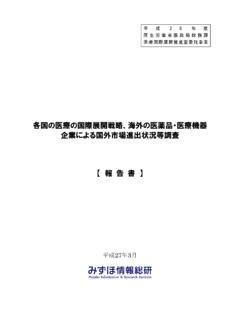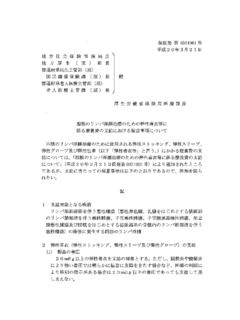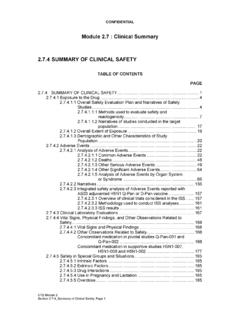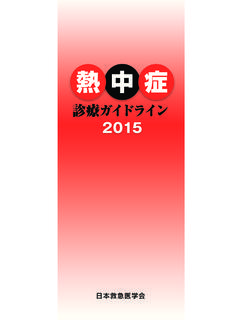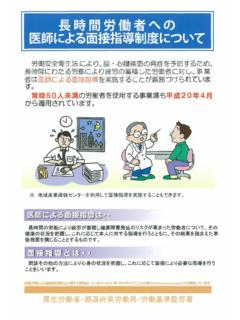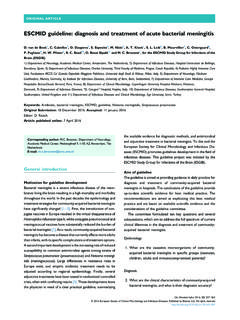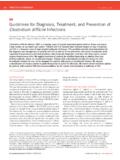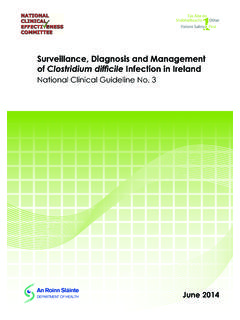Transcription of Manual of Antimicrobial Stewardship (1st Edition)
1 Manual of Antimicrobial Stewardship (1st Edition). The Government of Japan Ministry of Health, Labour and Welfare Health Service Bureau Tuberculosis and Infectious Diseases Control Division Table of Contents 1. Introduction .. 1. (1) Background .. 1. (2) Purpose of the Manual .. 1. (3) Target Readers .. 2. (4) Target Patient 2. (5) Manual Development Processes .. 2. 2. General 4. (1) What is Antimicrobial Stewardship ? .. 4. (2) Indications for Antimicrobials .. 4. (3) Inappropriate and Unnecessary Use of Antimicrobials .. 4. (4) Miscellaneous .. 5. 3. Acute Respiratory Tract Infection (ARTI) .. 6. (1) What is acute respiratory tract infection? .. 6. (2) Epidemiology of ARTI .. 6. (3) Diagnosis and Differential Diagnoses of ARTI .. 7. (4) treatment of ARTI .. 11. (5) Explanations to Patient and Family Education .. 16. 4. Acute Diarrhea .. 20. (1) What is Acute Diarrhea? .. 20. (2) Epidemiology of Acute Diarrhea .. 20. (3) Diagnosis and Differential Diagnoses of Acute Diarrhea .. 20. (4) treatment of Acute Diarrhea.
2 22. (5) Patient and Family Education .. 26. 5. Appendix .. 29. (1) To Better Understand Antimicrobial Stewardship .. 29. (2) What is Delayed Antibiotics Prescription? .. 32. (3) Check list for Clinical Management of ARTI and Acute Diarrhea .. 33. 6. Reference .. 35. Introduction 1. Introduction (1) Background Antimicrobials*1 are of paramount importance in today's health care and have contributed greatly to the treatment of infectious diseases and reduction in morbidity and On the other hand, antimicrobials can cause adverse effects and therefore need to be used in an appropriate As a result of misuse of antimicrobials, Antimicrobial resistance (AMR) has been recently recognized as a major global public health Without appropriate measures, it is estimated that there will be 10 million deaths per year due to organisms with AMR in ,3 The development of new Antimicrobial agents has been stagnant since the 1980s, while AMR has posed significant threats to public There is a concern, therefore, that without appropriate Antimicrobial use today, effective Antimicrobial agents may run out in the This situation must be averted; and Antimicrobial Stewardship is an important strategy to combat AMR.
3 A global action plan on AMR was adopted at the World Health Assembly in May 2015, and was followed by a national action plan on AMR adopted by the Government of Japan in April Antimicrobial Stewardship has been set as one of the important strategies and needs to be promoted among all stakeholders including medical professionals and patients in everyday A study on Antimicrobial consumption in Japan based on sales data showed Japan consumed Defined Daily Doses (DDDs)*2 per 1,000 inhabitants per day in 2013. and oral Antimicrobial agents accounted for of the total Compared to other countries, Japan consumed a relatively higher proportion of oral third-generation cephalosporins, fluoroquinolones and ,5 Little is known about the misuse of antimicrobials in Japan, but for example, a report from the USA. showed about 30% of total Antimicrobial use was Therefore, it is reasonably assumed that a certain proportion of Antimicrobial use in Japan is also not appropriate and this needs to be addressed in Japan.
4 This Manual aims to promote Antimicrobial Stewardship by providing clear guidance to improve the clinical management of selected infectious diseases. (2) Purpose of the Manual The purpose of this Manual is to improve the clinical management of infectious diseases, leading to a reduction in inappropriate and unnecessary use of Antimicrobial agents without causing harm to patients. Japan's national plan on AMR. sets Reduce Antimicrobial use per day per 1,000 inhabitants in 2020 to two-thirds of the level in 2013 as one of the outcome indices,1 and it is noted that those outcome indices should be achieved through promoting appropriate infectious disease practice. *1. There are multiple relevant terminologies with different definitions. However, in reality, the following terms are often used interchangeably by the general public in Japan to mean drugs effective against bacteria: Antimicrobial agents, antimicrobials: Antimicrobial agents, or antimicrobials, are active against microorganisms, which are generally categorized into bacteria, fungi, viruses and parasites.
5 These are the general term for drugs to treat and prevent infectious diseases. They contain antibacterial agents, antifungal agents, antiviral agents and antiparasitic agents. antibacterial agents: Antimicrobial agents that are active against bacteria. antibiotics: informally defined as an agent that is derived from bacterial sources to inhibit and control cell activities of microorganisms antibiotic agents: another term for drugs that use the antibacterial action of antibiotics *2. DDD: DDD stands for Defined Daily Dose. It represents the average dose for an adult when an Antimicrobial agent is used for its main disease indication. The World Health Organization provides the DDD for each agent. Manual of Antimicrobial Stewardship (1st edition) 1. Introduction (3) Target Readers This Manual is intended for medical professionals, particularly physicians who examine, prescribe for, and counsel patients in an outpatient setting. The Manual does not provide appropriate Antimicrobial use in an inpatient setting.
6 Topics that are controversial even among experts were excluded from the Manual . Seeking expert consultation and referring to academic literatures are encouraged for topics beyond the scope of the Manual , such as alternative recommendations for those with a penicillin allergy. As noted above, a large proportion of Antimicrobial consumption in Japan is explained by oral Antimicrobial agents and, presumably, a substantial share of the oral third-generation cephalosporins, fluoroquinolones and macrolides are prescribed in outpatient settings. Therefore, the Manual is structured so as to help medical professionals distinguish the outpatient clinical situations where Antimicrobial agents are indicated from those where they are not. Moreover, the Manual is expected to be helpful to other medical professionals who are not directly involved with Antimicrobial prescription, and it is highly recommended that all who are involved in health care including patients read the Manual in order to fully promote Antimicrobial Stewardship .
7 (4) Target Patient Populations The indications for Antimicrobial use in outpatient settings are relatively limited since many clinical entities such as acute respiratory tract infections (ARTI) and acute diarrhea do not require antimicrobials. In order to promote optimal use of specific Antimicrobial agents, the latter half of the Manual focuses on the clinical management of ARTI and acute diarrhea because it is believed that antimicrobials are often unnecessarily prescribed for these two common conditions based on the available evidence regarding misuse of antimicrobials and the type of Antimicrobial agents commonly prescribed in ,6 The target subjects of the Manual are healthy, immunocompetent adult and pediatric (school aged children and above) patients. Infants are excluded as particular attention to the age-specific pathophysiology is often required for infants. The Summary of Product Characteristics (SPC) of each medication needs to be referred to for appropriate prescription with the right dose and frequency.
8 In the appendix, the Manual contains relevant documents to support clinical practice according to the recommendations given within. (5) Manual Development Processes While major clinical guidelines developed by the Japanese Association for Infectious Diseases (JAID), Japanese Society of Chemotherapy (JSC), Japanese Society for Pediatric Infectious Diseases (JSPID), Oto-Rhino-Laryngological Society of Japan, Japanese Rhinologic Society, the US Centers for Disease Control and Prevention (CDC), American College of Physicians (ACP), Infectious Diseases Society of America (IDSA), American Academy of Pediatrics (AAP), European Society of Clinical Microbiology and Infectious Diseases (ESCMID), National Institute for Health and Care Excellence (NICE) and others were referred to, a review of the literature on ARTI was made for meta-analyses, systematic reviews and randomized clinical trials in order to formulate recommendations based on the latest Manual of Antimicrobial Stewardship (1st edition) 2.
9 Introduction scientific evidence. Cochrane Library, PubMed and Ichushi (Japan Medical Abstracts Society) were used as search websites for articles published as of December 31, 2016. Acute bronchitis OR respiratory tract infection OR pharyngitis OR. rhinosinusitis OR the common cold as Medical Subject Headings (MeSH) terms were used for English articles while acute bronchitis OR respiratory tract infection . OR pharyngitis OR rhinosinusitis OR common cold were used for Japanese articles. For acute diarrhea, while major clinical guidelines developed by JAID/JSC, IDSA, the American College of Gastroenterology (ACG), World Gastroenterology Organization (WGO) and others were referred to, a similar search strategy was adopted with the search terms of diarrhea and ( acute disease OR infectious diarrhea OR dysentery OR acute gastroenteritis ) as MeSH terms for English articles, and gastroenteritis OR acute diarrhea for Japanese articles. Of note, the patient population of the literature review was limited to immunocompetent adult or pediatric patients without chronic lung disease for ARTI, and immunocompetent adult or pediatric patients without chronic bowel disease for acute diarrhea.
10 Manual of Antimicrobial Stewardship (1st edition) 3. General principal 2. General Principles (1) What is Antimicrobial Stewardship ? Antimicrobial Stewardship *3 is a concept involving measures and interventions taken in order to improve optimal Antimicrobial Antimicrobial Stewardship aims to help determine indications for antimicrobials and optimal Antimicrobial regimens with the right route, dose, frequency and duration, leading to improving patients'. outcomes and the minimization of adverse events caused by antimicrobials. The activities reported in the literature include prospective audits with direct feedback to those who prescribe antimicrobials, limited access to particular Antimicrobial agents with preauthorization, education and promotion for optimal Antimicrobial use, facility-specific guideline development for de-escalation of antimicrobials and treatment guidance, change from intravenous to oral regimens, use of rapid diagnostics, and interventions to delay Antimicrobial 9 In actual clinical settings, the above activities are utilized singly or in combination.
